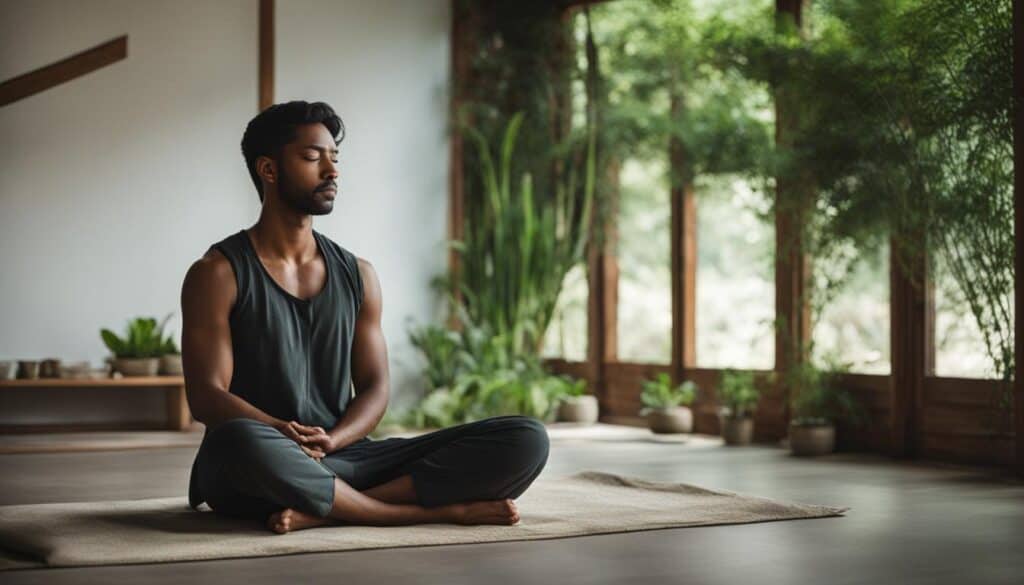Welcome to the Beginner’s Guide to Meditation, where we will explore the transformative practice of meditation and mindfulness. In today’s fast-paced world, finding inner peace and clarity is more important than ever. Meditation offers a practical and accessible way to calm the mind, reduce stress, and enhance focus. Whether you are new to meditation or looking to deepen your practice, this guide will provide you with valuable insights and techniques to get started on your journey towards a more mindful and balanced life.
Key Takeaways:
- Meditation and mindfulness are powerful practices for calming the mind and enhancing focus.
- Regular meditation practice has numerous benefits, including stress reduction and improved emotional well-being.
- There are various types of meditation techniques to choose from, allowing you to find a practice that resonates with you.
- Starting a meditation practice can be simple, with just a few minutes of daily mindfulness.
- Creating a dedicated meditation space can enhance the effectiveness of your practice.
What is Meditation?
Meditation is a practice that involves focusing the mind and inducing a state of deep relaxation and heightened awareness. It is a way to quiet the noise in our minds and connect with our inner self. Through meditation, we can cultivate a sense of inner peace, clarity, and mindfulness.
There are different techniques for meditation, but the core principle remains the same: to be fully present in the moment and observe our thoughts and sensations without judgment. It can be done by sitting in a quiet space and focusing on the breath, repeating a mantra, or directing our attention to an object of concentration.
“Meditation is not a means of escape from reality but a way of addressing it.”
Meditation is not about escaping from reality; rather, it is about facing it with a calm and centered mind. By practicing meditation regularly, we can train our minds to become more focused, resilient, and compassionate. It allows us to tap into our inner wisdom and find a sense of balance amidst the chaos of daily life.
The Benefits of Meditation

Meditation has been practiced for centuries and is known for its numerous benefits to both the mind and body. Incorporating meditation into your daily routine can have a profound impact on your overall well-being and lead to a more mindful and fulfilling life.
Reduced Stress and Anxiety
One of the key benefits of meditation is its ability to reduce stress and anxiety. By focusing your attention and quieting your mind, meditation helps to calm the nervous system and promote a sense of relaxation. Research has shown that regular meditation practice can significantly reduce stress levels and improve overall mental health.
Improved Focus and Clarity
Meditation is a practice of training the mind to stay focused and present. Regular meditation practice can enhance your ability to concentrate and improve your overall cognitive function. It can also sharpen your memory and increase your productivity. By training your mind to stay focused during meditation, you can carry this enhanced focus into your daily tasks and activities.
Enhanced Emotional Well-being
Meditation is also known to promote emotional well-being by increasing self-awareness and cultivating a sense of inner peace. Regular meditation practice can help you gain a better understanding of your emotions and develop a healthier relationship with them. It can also provide a safe space for self-reflection and help you develop a more positive outlook on life.
Overall, the benefits of meditation are vast and can have a profound impact on your physical, mental, and emotional well-being. By incorporating meditation into your daily routine, you can experience reduced stress and anxiety, improved focus and clarity, and enhanced emotional well-being.
Different Types of Meditation

Meditation is a versatile practice that offers a variety of techniques to suit different preferences and goals. Here are some of the most common types of meditation:
- Mindfulness Meditation: This technique involves focusing on the present moment and observing thoughts, feelings, and sensations without judgment. It helps develop self-awareness and acceptance.
- Loving-Kindness Meditation: Also known as Metta meditation, this practice involves cultivating feelings of love, compassion, and kindness towards oneself and others. It helps foster positive emotions and empathy.
- Transcendental Meditation: This technique involves the use of a mantra, a specific word or phrase repeated silently, to transcend thought and enter a state of deep relaxation and expanded awareness.
- Guided Visualization: In this practice, a guide or recording leads you through a series of visualizations to create a vivid mental image. It helps to promote relaxation, focus, and clarity.
Each type of meditation offers its own unique benefits and can be tailored to individual preferences and needs. It’s important to explore different techniques and find the one that resonates with you the most.
Benefits of Different Techniques
“Mindfulness meditation enhances self-awareness and acceptance, loving-kindness meditation promotes compassion and empathy, transcendental meditation induces deep relaxation and expanded awareness, and guided visualization improves focus and clarity.”
By incorporating different types of meditation into your practice, you can cultivate a well-rounded approach to mindfulness and experience a wide range of benefits for your mental, emotional, and physical well-being.
How to Start Meditating

Starting a meditation practice can feel intimidating, but it doesn’t have to be. With a few simple steps, you can begin your journey towards inner peace and mindfulness. Here are some beginner meditation tips to help you get started:
- Set aside a dedicated time and space: Find a quiet and comfortable space where you can sit uninterrupted for a few minutes each day. Set a specific time that works best for you, whether it’s in the morning or before bedtime.
- Start with short sessions: When you’re just beginning, aim for shorter meditation sessions of 5 to 10 minutes. As you become more comfortable, gradually increase the duration of your practice.
- Focus on your breath: One of the simplest techniques for meditation is to focus on your breath. Close your eyes and take slow, deep breaths, paying attention to the sensation of each inhale and exhale. Whenever your mind wanders, gently bring your focus back to your breath.
- Be patient and compassionate with yourself: It’s common for thoughts to arise during meditation. Instead of getting frustrated, simply acknowledge the thoughts and let them go. Remember that meditation is a practice, and it’s okay to have distractions or moments of restlessness.
Remember, the goal of meditation is not to completely clear your mind, but rather to cultivate a sense of presence and awareness. With consistent practice, you’ll begin to experience the numerous benefits that meditation has to offer.
Tips for a Successful Meditation Practice
Here are a few additional tips to help you establish a successful meditation practice:
- Be consistent: Try to meditate at the same time each day to establish a routine. Consistency is key to reaping the full benefits of meditation.
- Use guided meditations: If you find it challenging to stay focused or are unsure where to start, consider using guided meditation apps or recordings. These can provide helpful guidance and structure to your practice.
- Join a meditation group: Connecting with others who share your interest in meditation can provide support and motivation. Look for local meditation groups or online communities where you can share experiences and learn from others.
- Be kind to yourself: Don’t judge or criticize yourself for having thoughts or struggling to stay focused. Meditation is a personal journey, and every experience is unique. Practice self-compassion and patience as you continue to develop your practice.
By following these beginner meditation tips and incorporating meditation into your daily life, you’ll gradually cultivate a sense of calm, clarity, and inner peace.
Creating a Serene Meditation Space
Creating a dedicated meditation space can greatly enhance your practice and provide a peaceful environment for deepening your mindfulness. A serene meditation space allows you to disconnect from the outside world and connect with your inner self. It is a sanctuary where you can find solace, clarity, and focus. Here are some tips to help you create a serene meditation space:
- Choose a quiet area: Find a quiet corner or room in your home where you can meditate without distractions. It could be a spare room, a cozy nook, or even a corner of your bedroom. Ensure that the space is away from noise and interruptions.
- Decorate mindfully: Add elements to your meditation space that promote relaxation and tranquility. Consider using soft colors, soothing textures, and natural materials. Incorporate items such as candles, incense, crystals, or plants to create a serene atmosphere.
- Create a comfortable sitting area: Invest in a comfortable meditation cushion or chair that supports good posture. Choose a sitting position that allows you to relax and maintain focus. You may also want to include a blanket or shawl to keep yourself warm during longer meditation sessions.
- Minimize distractions: Ensure that your meditation space is free from clutter and distractions. Keep electronic devices, such as smartphones or tablets, out of sight. Consider using soft lighting or dimmer switches to create a calming ambiance.
- Set the mood: Enhance the atmosphere of your meditation space by playing soft, instrumental music or nature sounds. You can also use aromatherapy diffusers with essential oils to create a soothing scent.
Remember, your meditation space is a reflection of your inner state. Keep it clean, organized, and inviting. As you enter this sanctuary, let it be a reminder to leave behind the outer chaos and enter a state of calm and stillness.
“A serene meditation space allows you to disconnect from the outside world and connect with your inner self.”
Mindful Living: Incorporating Mindfulness into Daily Life
Living mindfully goes beyond formal meditation practice; it is about bringing awareness and presence into every aspect of our daily lives. By incorporating mindfulness into our daily routines, we can cultivate a greater sense of peace, clarity, and well-being. Here are some practical ways to incorporate mindfulness into your daily life:
- Start your day mindfully: Begin your day by taking a few moments to set an intention or focus on your breath. This can help you start the day with a sense of calm and presence.
- Eat mindfully: Instead of rushing through meals, take the time to savor each bite. Pay attention to the taste, texture, and aroma of the food, and notice how it nourishes your body.
- Practice mindful movement: Whether it’s walking, yoga, or any other form of exercise, bring awareness to the sensations in your body as you move. Notice the rhythm of your breath and the feeling of your feet on the ground.
- Engage in mindful listening: When someone is speaking to you, give them your full attention. Put away distractions, maintain eye contact, and truly listen to what they are saying without interrupting or planning your response.
“Mindfulness is the key to unlocking the full potential of each moment. By being fully present, we can experience the richness and joy that life has to offer.”
Cultivating mindfulness in daily life requires practice and intention. It may take time to develop the habit of being fully present and aware, but with consistent effort, it will become a natural part of your day. Remember to be kind and patient with yourself as you embark on this journey of mindful living.
Incorporating mindfulness into your daily life can have a profound impact on your well-being. It can help reduce stress, improve focus, enhance relationships, and promote a greater sense of happiness and fulfillment. Start by choosing one activity each day to practice mindfully, and gradually expand it to other areas of your life. With time, mindfulness will become a way of being, allowing you to fully experience the richness and beauty of each moment.
Overcoming Common Meditation Challenges

Meditation offers numerous benefits, but it can also come with its fair share of challenges. However, with a little patience and perseverance, you can overcome these obstacles and continue to reap the rewards of a regular meditation practice. Here are some common challenges you may encounter and practical tips for overcoming them:
Frequent Distractions
One of the most common challenges in meditation is dealing with a wandering mind. Thoughts, worries, and distractions can easily pull you away from your focus. Instead of getting frustrated, acknowledge these distractions without judgment and gently bring your attention back to your breath or chosen focal point. It may take time and practice, but over time, you’ll develop greater mental clarity and the ability to sustain focus.
Physical Discomfort
Sitting in one position for an extended period can lead to physical discomfort, such as stiffness or pain. To overcome this challenge, find a comfortable seated position that supports proper alignment of your spine. You can use cushions, bolsters, or meditation benches to provide additional support. If sitting on the floor is not comfortable for you, you can also try practicing meditation in a chair. The key is to find a position that allows you to be relaxed and alert.
Lack of Time
Busy schedules can make it challenging to find time for meditation. However, even a few minutes of daily practice can make a difference. Consider incorporating meditation into your morning or evening routine, or find small pockets of time throughout the day to pause and connect with your breath. You can also try mindfulness techniques during everyday activities, such as mindful eating or walking. Remember, consistency is more important than the duration of each session.
By persisting through these challenges and staying committed to your practice, you will gradually experience the transformative power of meditation. Embrace the process, be patient with yourself, and trust that with time, you will develop a more profound sense of calm, focus, and well-being.
Deepening Your Meditation Practice
Once you have established a regular meditation practice, you may wish to explore advanced techniques to deepen your experience. These techniques can help you further cultivate mindfulness, enhance self-awareness, and achieve a greater sense of peace and clarity. Here are some advanced meditation techniques to consider:
1. Breathwork
Breathwork involves consciously controlling your breath to influence your state of mind and promote relaxation. Techniques like alternate nostril breathing, box breathing, and Kapalabhati can help calm the mind, increase energy, and improve focus during meditation.
2. Body Scanning
A body scanning meditation involves systematically scanning your body from head to toe, bringing your attention to each body part and observing the sensations present. This technique helps develop a deep mind-body connection, increase body awareness, and release tension or stress stored in different areas of the body.
3. Visualization
Visualization meditation involves creating vivid mental images to enhance focus, concentration, and relaxation. You can visualize a peaceful nature scene, a healing light, or any image that brings you a sense of calm and tranquility.
“Visualization can be a powerful tool in meditation, allowing you to tap into your imagination and create a mental sanctuary where stress and worries melt away.”
Remember, it’s essential to approach advanced techniques with patience and take the time to find what works best for you. Attending meditation retreats or seeking guidance from experienced teachers can also provide valuable support and help you deepen your practice even further.
Maintaining Consistency in Meditation Practice
Consistency is key when it comes to meditation practice. Just like any habit or skill, regular practice is essential for reaping the full benefits. Here are some tips to help you maintain consistency and stay motivated on your meditation journey:
- Set realistic goals: Start with small, achievable goals that fit into your schedule. Commit to a specific number of minutes or sessions per day and gradually increase the duration as you progress.
- Establish a routine: Create a daily meditation ritual by choosing a specific time and place for your practice. Having a dedicated space where you can immerse yourself in meditation will make it easier to stay consistent.
- Find motivation: Remind yourself of the positive effects meditation has on your well-being. Reflect on the mental, emotional, and physical benefits you have experienced and use them as a source of motivation to keep going.
- Connect with a community: Join a meditation group or find an online community of like-minded individuals. Sharing your journey with others and receiving support can help you stay inspired and accountable.
- Seek guidance: Consider seeking guidance from experienced meditation teachers or attending retreats. These opportunities can provide valuable insights, deepen your practice, and keep you motivated to continue.
Remember, consistency doesn’t mean perfection. Even if you miss a day or have a challenging session, don’t be discouraged. Every moment spent in meditation counts and contributes to your overall growth and well-being. Stay committed, stay motivated, and watch as your meditation practice transforms your life.
Maintaining Consistency: A Quote to Remember
“The more regularly and the more deeply you meditate, the sooner you will find yourself acting always from a center of peace.” – J. Donald Walters
Meditation and Mindfulness: Cultivating Inner Peace and Awareness
Meditation and mindfulness are closely intertwined practices that can help individuals cultivate inner peace, clarity, and overall well-being. Meditation serves as a foundation for mindfulness, while mindfulness, in turn, enhances the practice of meditation.
When we engage in meditation, we focus our attention on a specific object or anchor, such as the breath, a mantra, or an object of concentration. Through this focused attention, we develop the ability to observe our thoughts, emotions, and physical sensations without judgment or attachment. This awareness is the essence of mindfulness.
By cultivating mindfulness through meditation, we can bring this quality of non-judgmental awareness into our daily lives. We become more present in each moment, fully engaged in our experiences, and more attuned to our own thoughts and emotions. This heightened state of awareness allows us to respond to life’s challenges and joys with greater clarity and compassion.
Benefits of the Meditation-Mindfulness Connection
The link between meditation and mindfulness is a powerful one, offering numerous benefits for our well-being. By practicing meditation, we cultivate the ability to be present and aware, which can improve our focus, enhance our emotional well-being, and reduce stress and anxiety. Mindfulness, on the other hand, supports our meditation practice by bringing a non-judgmental attitude and heightened awareness to each moment.
“The present moment is the only time over which we have dominion.” – Thich Nhat Hanh
When we integrate meditation and mindfulness into our daily lives, we create a harmonious relationship between our inner and outer worlds. We become more attuned to our own thoughts, emotions, and physical sensations, as well as the world around us. This deepened awareness allows us to navigate life’s challenges with greater resilience and cultivate a sense of peace and well-being.
Incorporating Meditation and Mindfulness
There are various ways to incorporate meditation and mindfulness into our daily routine. Beginning with a few minutes of meditation each day can help establish a foundation for mindfulness in everyday life. As we continue to practice, we can bring mindfulness to our daily activities, such as eating, walking, or engaging in conversations.
By creating a regular meditation practice and infusing mindfulness into our daily lives, we can tap into the transformative power of these practices and experience greater presence, peace, and overall well-being.
Conclusion
In conclusion, meditation and mindfulness are powerful practices that can bring about profound positive changes in our lives. By incorporating these practices into our daily routine, we can experience greater peace, focus, and overall well-being.
The benefits of meditation are extensive, from reducing stress and anxiety to improving focus and emotional well-being. Moreover, mindfulness allows us to be fully present in the moment, without judgment, fostering a deeper connection with ourselves and the world around us.
Whether you are just starting out or looking to deepen your practice, now is the perfect time to embark on a journey of self-discovery through meditation and mindfulness. Start small, be consistent, and gradually explore different techniques that resonate with you. Through patience and dedication, you can tap into the transformative power of these practices and cultivate a more mindful and compassionate way of living.
 Fullersears
Fullersears





